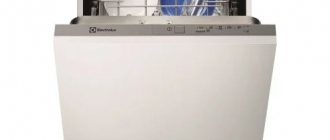The equipment must match the furniture in size. Manufacturers produce their products according to the standards necessary to ensure that the equipment fits perfectly into a set or wall. Of course, standards vary, but there are not many options. Selecting a standard option is not difficult. To do this, just take measurements using a tape measure. You need to measure the width, depth and height of the niche or the space between adjacent sidewalls if the top of the household appliance will serve as the countertop. Connecting to the pipeline and sewerage should also not be a problem. This is no more difficult to do than installing a sink faucet. However, situations arise when it is not entirely clear how to integrate a dishwasher into a finished kitchen. Situations can be standard and non-standard. Let's consider what options there may be.
Choosing a location for installation
First of all, it is necessary to determine where the unit will stand. The closer it is to the pipes with hot and cold water, the less communications will have to be pulled. Proximity to a sewer pipe is equally important. The closer the drain, the greater the angle of inclination of the drain pipe. If it is located at a distance of several meters, the length of the flexible wiring may simply not be enough, and waste water containing food waste will stagnate inside in sagging areas.
In such situations, hard plastic or metal pipes are usually used, which makes installation more expensive, but this is the only way to avoid sagging. If the distance is large and the entrance to the sewer is located high, the technician will have to be raised on a pedestal to increase the angle of inclination of the drain pipe. All these troubles can be avoided by placing it near the sink.
Any equipment does not tolerate high temperatures well, so it is better to place it away from the radiator, stove and oven. Proximity to other household appliances is not desirable, but not dangerous either. Electromagnetic fields and static electricity will not cause serious harm to the motor and pump, but their operating life will be slightly shortened.
Electrolux dishwasher
When choosing a location, it is important to consider the location of the outlets and the length of the wire. As a rule, it is 1.5 m. It is prohibited to connect equipment using an extension cord, and installing a new outlet is long and difficult. To do this, you will have to move the wall and pull the wire.
The plug must not be closed tightly. It should always be in plain sight so that if it catches fire, it can be pulled out immediately. Failure to comply with this condition may result in a fire.
How to connect to the sewer yourself
For equipment to work properly, it must be properly connected to the sewer system.
Directly into the sewer pipe outlet collar
This is the simplest method of connecting a dishwasher to a sewer drain pipe. In this case, the outlet hose is directly connected to the cuff. The connection point is reliably sealed so that water does not leak.
To the sink drain system
Sometimes it is not possible to connect directly to the sewer pipe and you have to connect the dishwasher to the washbasin drainage system. This is much more difficult, since you will have to buy a new siphon.
Connection to water supply
Dishwashers are connected to a cold water supply. Before connecting to the pipe, special filters are installed to purify the liquid. When connecting, a shut-off valve with a tee is installed, the joints are sealed with tape and sealant.
Read also: LED battery-powered emergency lamp
Power connection
Connecting your dishwasher to a power source is very simple. Just pull the cord to the outlet and plug it in.
Dimensions for built-in dishwasher
You can select the dimensions before purchasing on the website of the store or manufacturer. They must be a multiple of the height and width of the tabletop, as well as all the parameters of a niche or cabinet if the equipment needs to be hidden behind the door. Instead of a regular door, a decorative damper is often used, designed in the same way as the entire facade.
There are several standard solutions. The standard depth is 0.55 m. This leaves enough space of just under 50 cm for water supply and air cooling. For kitchen sets designed for standard apartments, narrow models with a width of 0.45 m are produced. It can vary up to 0.65 m. Most often it is 0.6 m. The height ranges from 0.815 to 0.875 m. It is a multiple of the height of ordinary countertops
There are dishwashers with minimal dimensions for installation. They are installed not only under the countertop. They are even located in the upper modules. The upper cabinets are narrower, and their depth is on average 15 cm less. In this case, problems with drainage should not arise even at a considerable distance from the siphon. You will only need to hide the drain pipe, connect the device to the water supply and resolve the electrical issue. Such devices have low productivity, but they are compact and consume less water and electricity.
Kitchen furniture manufacturers make a small margin by adding 2 mm on each side inside the modules. On the contrary, the built-in equipment is slightly smaller than the declared dimensions. This is necessary so that it fits into the niche prepared for it, even taking into account small irregularities.
The dimensions of the built-in dishwasher are one of the most important selection criteria. If it does not fit in size, it is better to refrain from purchasing and continue searching.
Complex installation of a new kitchen unit with a set of equipment is an ideal, but not always possible solution. It happens that a dishwasher is bought later, and there is no special cabinet for its installation. What needs to be done to ensure that the long-awaited purchase fits successfully into the furniture module?
You will learn everything about how to integrate a dishwasher into a finished kitchen from our article. We will talk about which equipment layout options have been tested in practice. Do-it-yourselfers will find a detailed step-by-step guide here.
An indispensable assistant in the kitchen
Regardless of the functional equipment, the dishwasher will be able to benefit the housewife in her everyday affairs. It saves time as well as water consumption. This is especially true in modern conditions, when one can only be amazed at how quickly utility tariffs are rising. This useful household appliance will be able to return the money spent on it in literally 2-3 years of active use.
Lately, many consumers don’t even think much about whether they need a dishwasher in their kitchen. Many people can no longer imagine their life without this useful unit, so after purchasing a stove and refrigerator they begin to think about this device. But in order for this equipment to work within the period that the manufacturer set for it, it is necessary to install it correctly.
Many owners install a dishwasher in their kitchen unit with their own hands, thereby hoping to save not only time, but also money. But this does not always go without complications, because not everyone is familiar with the nuances of this process. Even the fact that each model comes with installation instructions doesn't help them much. To do this, you need to have certain skills and knowledge that the average consumer simply does not have.
Dishwasher installation conditions
Before purchasing and installing a dishwasher, you need to find a suitable place for it.
The easiest way is with free-standing units - even a piece of free space on the floor or table is enough for them. But what to do when you plan to buy a built-in model that can be hidden behind a decorative panel?
You need to arm yourself with a construction tape and check which cabinets are suitable for installing a PMM. Finding out the sizes of dishwashers is easy - information is posted on the official websites of stores that sell household appliances.
When making machines, manufacturers are guided by human height and furniture sizes, and accordingly adapt their models to uniform standards.
For example, most dishwashers from well-known brands have a width of 60 cm (more precisely, 598 mm) or 45 cm (448 mm). 45-centimeter models are called narrow, and they have more options for embedding in a finished kitchen.
Narrow models usually have a height of 815 mm to 875 mm, which is equal to the standard height of kitchen tables and cabinets. If the set is made to order, the level of the countertops may be lowered for technical reasons, for example, a pipe is in the way, etc. Therefore, accuracy is needed when measuring - just one extra centimeter can be decisive.
The depth of the machines is 550 mm. During installation, a few centimeters remain for comfortable connection of hoses and wires so that they are not pinched. There is a category of compact cars that differ from full-size ones in height. For ease of use, they are usually built into the upper modules.
If you have found a cabinet that is suitable in size, do not forget to take into account the location of communications:
- cold water pipes;
- sewer pipe;
- free power line with socket.
An additional electrical cable can be laid if necessary, but it is hardly possible to move pipes in a ready-made kitchen, so the installation location of the machine is usually chosen next to the sink - this is where the main water supply and drainage units are located.
If at least one of the conditions is not met, for example, there is no suitable module or there is no access to communications, then you will have to postpone the purchase of a built-in dishwasher or think about remodeling the kitchen.
What kind of dishwashers are built under the sink: types
The dishwasher installation algorithm is described in the instructions provided by the manufacturer. Usually it consists of several stages, the first of which is preparatory.
In advance you need to purchase some parts for connecting to the pipes, take care of the socket arrangement, prepare a tool - a screwdriver, a screwdriver, a hammer, as well as flax or fume tape for plumbing connections, sealant, double tape.
In addition to the dishwasher, the kit usually contains templates for installing decorative trims, fastening tools, a protective rubber apron, gaskets, and hoses.
To make sure everything is in place, you need to find a list of components and check the presence of each of them. If something is missing, you will have to buy more.
The unpacking stage is often carried out in the presence of employees of the company selling the equipment.
If problems arise with the packaging, they can be quickly resolved with additional delivery. Be sure to check if there are installation instructions in Russian. Famous manufacturers duplicate the description of the installation process on official websites in special sections.
Before you begin installing the built-in model, you need to make sure that the cabinet is the right size and that there are holes in its walls for hoses.
Procedure:
- place the machine opposite the niche for embedding;
- pull the drain and inlet hoses through the holes to the connection points, and the power cord towards the outlet;
- carefully push the machine body into the place intended for it and make sure that the length of the hoses suits you;
- pull out the machine and prepare it for installation - carry out the manipulations described in the instructions: glue a vapor barrier film to the inside of the tabletop, attach sealing tapes to the edges, install a mounting plate, damping elements, etc.;
- adjust the height of the legs so that the body stands strictly vertical, check the distance to the walls of the niche with a tape measure;
- Attach noise protection to the bottom part, if included.
Next, you can begin installing decorative overlays. So that they do not differ from the kitchen facade, you can take the removed cabinet door and the panel from the drawer and fix them one by one on the car door, having previously processed and adjusted them to size.
Some tips for installing homemade trims.
Usually, to attach decorative overlays, the machine is equipped with long self-tapping screws - they need to be inserted in place of the short ones, which were screwed in initially. When the dishwasher is completely installed, all that remains is to connect the communications and test.
This is the easiest and fastest stage. The connection is made in one of two ways:
- insert the drain hose directly into the cuff of the sewer pipe outlet;
- connect the hose to the sink drain system.
The first option is possible if the sewer pipe has a free additional hole, which is located under the sink or not far from it.
Option for integration into a system with a water seal. Regardless of the method, the dishwasher drain hose is equipped with an Aquastop device and a shut-off valve to prevent leaks
For tapping into a pipe, a ¾-inch tee is usually used. If the hose is installed in a siphon, it is better to purchase a special model with an outlet.
Even if the model involves connecting to hot and cold water, in Russia it is recommended to supply only cold water. This is due to the impossibility of adjusting the temperature of hot water and the lack of special filters.
Installing a filter for cold water supply is mandatory, otherwise the equipment will quickly fail.
The insertion takes place in the standard way: install a tee and, of course, a shut-off valve. Cutting off the water supply is useful during repairs or replacement of parts
It is better to leave the places of threaded connections detachable, but seal them with fum tape or linen thread. Sealant is used as a last resort; people usually do without it.
The standard length of the dishwasher power cord is one and a half meters. Therefore, the distance to a separate outlet should be no more than 1.5 m.
It is not recommended to use a filter or extension cord - for the operation of powerful kitchen appliances, according to the rules, separate supply lines must be carefully laid.
It is not possible to lay the electrical cable inside the kitchen walls with a fully installed set, so it is laid in a box or inside the baseboard
To install a separate line, you will need a VVGng copper wire of 2-2.5 mm, a 16 A circuit breaker and a grounded socket.
During installation, repair or maintenance of the dishwasher, the power supply must be turned off. To do this, a separate power line serving the kitchen is turned off at the electrical panel. And if there is no such thing, then they turn off the power to the entire apartment/house.
After installing the dishwasher, it is necessary to check the operation - connect the power supply and activate the machine in test mode in preparation for the first start.
Installing appliances in a finished kitchen is not fundamentally different from conventional installation, but difficulties may arise with connecting communications.
Built-in dishwashers under the sink can be open or closed. The open ones have a panel located on the outside. For closed ones, it is hidden behind the door. Also, the devices can be fully or partially built under the sink.
We suggest you familiarize yourself with Dream of washing wooden floors
Possible embedding options
A cabinet for embedding a PMM may look different. We suggest considering several popular options that are convenient for installation.
Each type of installation is associated with difficulties. To minimize them, it is important to comply with the above conditions and requirements specified by the manufacturer in the instructions. We offer several recommendations for installing a dishwasher in different places.
Solution #1 – built into a closet
If there is a cupboard with a width of more than 45 cm next to the sink, then it can be used to install a dishwasher. The advantage of installation close to communications is the ability to integrate machine hoses into an already installed system under the sink.
You will have to remove the shelves and back wall from the cabinet, and, if necessary, the bottom panel. The built-in housing must be brought into a strictly vertical position; for this, adjustable legs are used.
Then you need to connect the machine one by one to the communications: sewerage, water supply and power supply. If necessary, an additional water seal with a drain pipe should be installed.
The decorative front panel, which is attached to the machine door, is usually assembled from removed cabinet doors or ordered additionally. Partially built-in models do not need to be decorated, so their installation is a little easier.
Solution #2 – installation in a separate module
If there are no free cabinets for new equipment, but there is enough space in the kitchen, you can order a separate module, but you need to install it near the communication nodes.
It is important to level and secure the unit so that it does not vibrate during operation or move the cabinet. Hoses and pipes are laid along the wall, but they are easier to access. To get to the communications, you don’t have to dismantle the car, but simply move the cabinet away from the wall.
If the dishwasher is installed under a common kitchen countertop, it must be removed for maintenance, since otherwise the hose connections cannot be reached.
Solution #3 – installation in a niche
If the kitchen has a niche for installing a microwave, oven or other small equipment, it can also be used to install a dishwasher. Dimensions of the compact model along with drawings can be found in the installation instructions.
Built-in compact models should not be confused with free-standing models. The latter do not have to be placed in a niche - any horizontal surface is suitable for their installation. So that the dishwasher is not conspicuous and is hidden like the rest of the equipment, the front part is covered with a decorative overlay in the style of a facade.
It’s easier to find a place for a compact model, but don’t forget that a mini-machine is not able to serve a large family.
Solution #4 – if embedding is not suitable
What to do if there is absolutely no space in the kitchen to install a built-in model? It remains to consider free-standing options, the design of which does not require special installation.
They can simply be installed on the floor, countertop or niche, leveled, and then connected.
There are still ways to fulfill your own dream of installing a built-in dishwasher - installing a facade on a free-standing model, completely renovating the kitchen unit, with possible repairs or relocation of communications. It is more expensive and requires not only financial investments, but also time.
Connection features
The built-in dishwasher must be located in the appropriate niche in the kitchen unit. That being said, there are some basic rules and regulations that must be followed.
There are the following requirements for the size of the place where the device will stand:
- The width of the niche should reach 60 centimeters for standard models;
- The width of the niche should reach 45 centimeters for narrow models.
In order to align the dishwasher with the kitchen drawers, you can temporarily remove the top countertop and tighten the legs of all parts of the furniture. In addition, if the cabinets do not have places for wires and hoses, they should be drilled. It is best to do this in those places where these elements come directly from the device itself.
The manufacturer strictly prohibits installing a dishwasher under the hob, as this does not comply with safety regulations.
Water supply connection
In order for the dishwasher to be serviced correctly and correctly, such a device must have an independent water supply. In some cases, you additionally need to install a special filter. It will allow you to clean the liquid so that no particles in it adversely affect the parts of the unit. This also applies to sand along with rust elements.
Having installed a water filter in front of the dishwasher, take care of the tap that would shut off this flow of liquid. Often, if it is missing, if breakdowns or damage occur, the house or apartment may flood. Most often this happens due to the opening of the fill valve in the dishwasher.
It will be interesting: Cleaning the shower stall from dirt, plaque and black mold
It is best to purchase a machine that has a special system for protecting against leaks. It is equipped completely differently in all models, since this directly depends on the manufacturer. Most often, drainage devices use a standard hose, the length of which is 1.5 meters. If it is not enough, using plumbing equipment, it can be slightly extended to enter the sewer system.
Sometimes dishwashers only require a cold water supply. Recently, models have begun to appear that take liquid immediately at an elevated temperature. This allows you to significantly save energy consumption. Currently, such a function may be unfavorable. This is due to the following factors:
- High cost of hot water;
- The presence of various impurities in hot water from the centralized supply system.
It is important to remember that the more foreign particles there are in the water, the faster the machine will eventually fail. It is highly recommended to allow this.
Draining
Installing a dishwasher yourself involves equipment for draining waste water. This part of the system is no less important than the fluid supply. It can be organized in two possible ways, such as:
- Connecting through a hose to the sink;
- By connecting directly to the sewer itself.
In the second case, you may need a special device that looks like a siphon. Its purpose is to prevent the possibility of waste water being pumped back into the dishwasher.
Many experts advise equipping a water drain with additional insurance. It involves organizing the system in such a way that the entry point into the sewer system is below the level where the hose itself passes. To do this, the latter should be secured at a height of about 50 centimeters from the area where it connects to the wastewater.
After this, making a slight bend, the hose should be connected to the installed siphon. Often it is not always possible to carry out such actions if the length of the pipeline does not exceed 1.5 meters. In such a situation, it should be lengthened. However, plumbers do not recommend using hoses longer than 3 meters. The maximum possible limit is 5 meters.
Power connection
In order to install a dishwasher, it is imperative to provide it with appropriate power. This is done using a copper three-core cable. Its cross-sectional diameter is only 2 millimeters. Such a reliable wire is used in order to provide an appropriate margin for the maximum load on the network.
To ensure that the dishwasher does not fail prematurely, it is necessary to install a fuse in the form of a 16 Ampere circuit breaker. It is able to turn off the device in cases where the power reaches 3.6 kW. In the event of a significant breakdown, such insurance will significantly save your budget and free time. Separately, please note that the machine must be connected in parallel with those already installed on other devices used in the house.
The dishwasher must be grounded. This is also one of the rules that increases the safety of operation of the unit. If the house is old, you need to remember that in this case the grounding must be connected to the zero phase of the shield. The use of special tires in such a situation is impractical.
Under no circumstances should you carry out grounding through gas, water supply and heat supply pipes. This is due to the fact that they are conductors, which may in the future become one of the reasons for the dishwasher to burn out. First of all, this applies to those cases when one of the residents of an apartment building decides to patch up a pipe using a welding machine.
Some craftsmen note that dishwashers should not be connected to the outlets that power the electric stove.
To carry out grounding, you should use sockets that have three poles with contacts. They are usually installed in the wiring conditions of individual apartments. It is best to use appliances that have full contact with the plug.
What should you consider when purchasing?
When choosing a dishwasher, you have to face many difficulties, so it is important to know in advance what to look for when purchasing. If preference is given to a non-built-in model, then the choice may be influenced by both the size and appearance of the equipment. The material for the manufacture of such machines is stainless steel; they do not require a furniture facade, since they have their own and are installed on the floor under the kitchen countertop.
Dimensions
The dimensions of dishwashers have certain standards. They are divided into full-size, narrow and compact. The standard dimensions are 870*600*600 mm (height, width, depth) for full-size machines, and 870*450*600 mm for narrow ones. This doesn't mean there aren't other options. You can also purchase wider models, for example, 800 mm. Externally, such a dishwasher will be close to a square shape. The capacity of this equipment is very large - up to sixteen sets of dishes.
Narrow dishwashers, in particular non-built-in ones, allow you to load up to nine sets at a time. Compact models take up very little space, and they are designed to be placed on a countertop rather than on the floor. Their height varies from 450 to 470 mm. The disadvantages of such machines include the visibility of hoses and wires, as well as a small load of dishes. But for one or two people this option is quite acceptable. Even narrow or compact equipment can save significant amounts of water.
The choice of dimensions of a non-built-in dishwasher depends not only on the size of the family, but also on the area of the kitchen. In a small room, no matter how much you want, it is impossible to find a place for large equipment, especially free-standing ones, but the spacious interior will allow you to fantasize with objects as you like.
The best option for small and medium-sized kitchens is a narrow dishwasher. It will take up only 400-450 mm of kitchen space under the countertop, but at the same time it will cope with a fairly large volume of dishes.
Unlike full-size appliances, it uses less water, detergent and electricity.
Appearance
The design of a freestanding dishwasher matters a lot. Despite its dimensions, the appliances must meet modern standards, be stylish and fashionable, and highlight the interior of the kitchen. Manufacturers offer a wide selection of models that differ not only in color, but also in shape, as well as other external parameters.
Class
This designation is used for dishwashers to determine the consumption of electricity, water, and the quality of washing and drying. There are three classes: A, B, C. The A-class includes elite dishwashing equipment, which economically consumes electricity and water, and ideally copes with washing and drying dishes. B and C are significantly inferior in quality to class A and are being produced less and less often.
Connection to water supply
There are three types of connection methods to the water supply: cold water only, hot water, and both. The first option is preferable for both full-size and narrow dishwashers, because cold water is much cleaner than hot water. Some people prefer this type, despite the high energy consumption for heating. Connecting to hot water saves electricity, but prevents the equipment from functioning during periods of no hot water supply.
Dish tray
Most manufacturers use stainless steel to make dish trays. This is due to its high strength, resistance to corrosion, durability, and wear resistance.
Plastic containers are also used in manufacturing. They attract with their light weight and reduced price for both built-in and free-standing dishwashers.
The shape and size of the trays also matter. For convenience, containers should accommodate not only plates, but also large utensils such as pots and pans. You also need to make sure that there are small shelves for cutlery so that during the washing process, forks and spoons do not spill all over the machine. Some trays are quite functional. They fold, disassemble, remove and adjust - it is very convenient to use. Tray designs for narrow and full-size machines differ.
First launch of the device
After all the previous steps have been completed in the form of connection, installation and testing, you need to begin the first start-up process. It should be done in idle mode as it aims to detect any problems or errors. In addition, this way the operation of the dishwasher is checked.
It will be interesting: Comparing the restoration of a bathtub with a liner and self-leveling acrylic
The dishes should not be loaded into the machine during the first run. The same applies to the use of detergents and regenerating salts. All device tanks should first be tested only with clean water. The first startup of the device performs tasks such as:
- Checking the correct operation of electronics;
- Checking the water supply and drainage;
- Checking the liquid heating process;
- Checking the filter system;
- Checking for third-party sounds and inaccuracies in operation.
There is actually nothing difficult about installing a dishwasher yourself at home. This process takes a little time, but at the same time it allows you to save a lot of money that a plumber would have received.
Dishwasher functionality
An important criterion for choosing a dishwasher is the set of certain functions. These include: washing programs, drying types, leakage protection system, noise level, as well as control and many other functions.
Washing programs
All built-in and free-standing dishwashers have several programs: gentle, moderate and intensive. The first is used for fragile dishes made of crystal, thin glass (glasses, wine glasses, vases, etc.), the water temperature during washing is 45-50 degrees. The moderate mode is suitable for daily use of any dishes, and the intensive mode will wash away the heaviest stains.
Some models have additional useful programs, such as: soaking in cold water, washing in economy mode, and automatically determining the degree of contamination.
The soaking program will allow you to leave the dishes to soak for some time from dried food residues, which can be easily removed with subsequent washing. Economy mode will use less water and electricity for lightly soiled dishes.
Drying types
There are also several types here: condensation, using fans and turbo drying. The first is the simplest and most time-consuming; it is used in more economical models. The liquid evaporates and exits through a special moisture receiver. The second type of drying is faster. Fans built into the body of the machine force air from the room inside, due to which the dishes dry out. Turbo drying is used for elite models; moisture evaporates due to the supply of hot air flow.
Leak protection system
This safety system is very important for any dishwasher. Thanks to special sensors built into the equipment, the water level and its overflow in the machine are monitored.
Noise level
All well-known manufacturers of dishwashing equipment equip them with various materials that reduce the noise of the operating appliance. This can be either special sound insulation of the walls of the machine, or pumps or motors with low noise levels. Naturally, the quieter the dishwasher is, the higher its cost.
Control
Two types of control are common: electronic and mechanical. The first has a number of advantages. Freestanding electronically controlled dishwashers have a stylish, modern design and many additional useful features, such as indicating the operating stage of the machine at the moment. But the price of such models is much higher than mechanical ones.
Dishwashers may also have other useful functions, such as ultraviolet sterilization of dishes, delay washing, timer, interior lighting of the machine, and others.
How does a dishwasher work?
To understand the principle of operation of dishwashing equipment, you can familiarize yourself with how it is designed. The required amount of water is drawn through a hose, connected at one end to the water supply and the other to a free-standing dishwasher. By the way, the hose may have additional protection against leaks.
Then the water is heated and enters the working compartment. Detergent is also supplied, in portions, at a certain time. A mixture of water and detergent is sprayed onto the dishes in jets of varying intensity, thereby cleaning them. Before starting the machine, you should carefully check the load of plates and cutlery, as incorrect placement can lead to poor results.
Using a special pump, contaminated water is drained into the sewer. So, several washing cycles occur. Clean dishes are rinsed with cold water and dried. The drying process depends on its type: condensation, turbo or using fans.
Tips for using your dishwasher
- Regular dishwasher detergents will not work as the process can create a lot of foam, which will lead to further problems with the machine.
- A chamber that is too crowded with dishes can cause ineffective washing. The result is unlikely to be positive.
- The dishes should be placed with the dirty side facing the spray arms, which are located in the central part of the machine. Do not place plates too close to each other.
- It is better not to wash steel and silver items together to avoid corrosion.
- Rinse aid is necessary for faster drying of dishes.
- If you load plastic products into the dishwasher, you should first make sure that they are resistant to high temperatures.
- To avoid clogging in the drain hose, remove large food debris from the dishes before loading.
A dishwasher in the house, narrow or full-size, is always a big plus. But in order for it to work properly, it is necessary to comply with certain requirements and operating rules described in the instructions. It is better to entrust the installation of dishwashers to specialists, especially if you do not have confidence in your own abilities.
In some cases, a freestanding dishwasher is not just a whim of the owners, but a real salvation. It is necessary if you have to wash mountains of dirty plates and pots every day. Its presence in the kitchen will save time and use it for more important and pleasant concerns.
Rules for connecting the device to electricity
In order for the dishwasher to operate, it must be connected to the power supply.
You will need high-quality European standard sockets with an excellent ground wire. If we are talking about a multi-story building, then the grounding wire is connected to a solid neutral. And if the sockets in the house have not yet been grounded, then it is better to call an electrician for this. Cleaning sewer pipes with soda and vinegar
It is highly not recommended to change the standard plug to a simplified type plug on the dishwasher cord, since you will not only lose the warranty on the device, but also risk health and life when using it.
To connect the machine to electricity, you will need to install an additional socket 250-300 mm from the floor level. The power cord for it is short, since it cannot be plugged into a regular outlet. The socket is made specifically for the dishwasher and is removed from the main contact connection using a 16-amp machine. This is required to ensure the safety of using the dishwasher.











